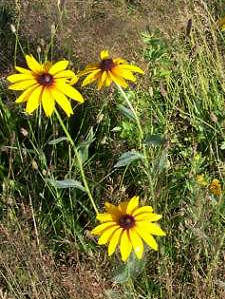 Echinacea, or Purple Coneflower, has been chosen Herb of the Year for 2002 by the International Herb Association and the Herb Society of America. Well-publicized as a
medicinal herb, echinacea is not always thought of as a beautiful herbaceous perennial whose flowers will brighten any garden.
Echinacea, or Purple Coneflower, has been chosen Herb of the Year for 2002 by the International Herb Association and the Herb Society of America. Well-publicized as a
medicinal herb, echinacea is not always thought of as a beautiful herbaceous perennial whose flowers will brighten any garden.
The name echinacea comes from the Greek echinos meaning "hedgehog,"probably a reference to its spiny seed cone. A member of the daisy family, echinacea is a native North American plant, most often found in the eastern and central U.S. and southern
Canada, in dry prairies, open woods, and along the roadside. It is one of the best perennial flowers for supplying constant bloom well into early fall.
Evidence of its use by Native Americans has been found in archeological digs dating back to the early 17th century. We know that Native American herbalists used it to treat many maladies, including snakebite, colds, colic, burns, toothache, and
rabies.
There are nine species of echinacea, and about fifty cultivated hybrids. In our area, five species are available commercially. Echinacea angustifolia is the smallest with pink, purple-pink and (rarely) white flowers. Echinacea purpurea is the best
known species and the parent of most hybrids such as 'Magnus' and 'White Swan.' Echinacea pallida can grow up to four feet tall and has pale pink, mauve, or white drooping petals. Echinacea paradoxa has yellow flowers and is considered to be rare and unusual. Echinacea
tennesseensis is endangered in the wild; it has purple upturned petals. Other species are the rare Appalachian species, E. laeviagata; E. similata, found only in the Ozarks; E. sanguinea from Louisiana and Texas; and E. atrorubens from eastern Kansas and Oklahoma.
Coneflowers are easy to grow in zones 3 to 9. E. purpurea seed germinates fairly easily in 10-20 days, but is best seeded in pots to eliminate weed competition until the plant is well established. Under optimum conditions, given moderately fertile
soils and enough water in mid summer when it is setting seed, it will self seed. It can also be propagated by root division. The seed of the other varieties has a much lower germination rate and requires a stratification period (cold treatment) of 4-12 weeks. E.
angustifolia seed is also best soaked for 24 hours before planting.
|

Black-eyed Susan
Rudbeckia hirta |
The soil in which echinacea is grown should be fairly well drained with a pH of 6 to 8; E. angustifolia needs a lime-rich soil. Only a light fertilizing when planting is necessary. Once established, echinacea is very drought-tolerant and seldom needs
watering. The only thing that will shorten its lifespan is heavy clay soils or constantly damp soils. It does not like to have its roots constantly wet. Weed control is also essential, especially with young plants.
Echinacea grows best in full sun but will tolerate light shade. It will flower from June to October; its seed cone is a favorite of butterflies and seed-eating birds. In the garden it combines well with grasses and other prairie plants like liatris,
coreopsis, tradescantia, and black-eyed Susans. Although the petals will drop when the flower is hang-dried, the seed cone makes a nice addition to dried fall flower arrangements. During cold, dry winters, covering echinacea plants with hay or evergreens will help prevent
root damage.
Echinacea well deserves the title of Herb of the Year. Consider growing these hardy coneflowers in your sunny perennial border if you are looking for blooming flowers that last all season long.
Sage: Herb of the Year 2001